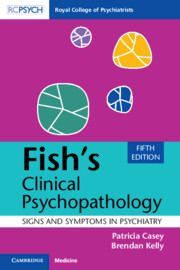Book contents
- Fish’s Clinical Psychopathology
- Fish’s Clinical Psychopathology
- Copyright page
- Contents
- Preface
- 1 Classification of Psychiatric Disorders
- 2 What Is Psychopathology?
- 3 Disorders of Perception
- 4 Disorders of Thought and Speech
- 5 Disorders of Memory
- 6 Disorders of Emotion
- 7 Disorders of the Experience of Self
- 8 Motor Disorders
- 9 Disorders of Consciousness
- 10 Personality Disorders
- Book part
- Index
- References
6 - Disorders of Emotion
Published online by Cambridge University Press: 12 January 2024
- Fish’s Clinical Psychopathology
- Fish’s Clinical Psychopathology
- Copyright page
- Contents
- Preface
- 1 Classification of Psychiatric Disorders
- 2 What Is Psychopathology?
- 3 Disorders of Perception
- 4 Disorders of Thought and Speech
- 5 Disorders of Memory
- 6 Disorders of Emotion
- 7 Disorders of the Experience of Self
- 8 Motor Disorders
- 9 Disorders of Consciousness
- 10 Personality Disorders
- Book part
- Index
- References
Summary
It is customary to distinguish between feelings and emotions. A feeling can be defined as a positive or negative reaction to some experience or event and is the subjective or experiential aspect of emotion. By contrast, emotion is a stirred-up state caused by physiological changes occurring as a response to some event and which tends to maintain or abolish the causative event. The feelings may be those of depression, anxiety, fear and so on. Mood is a pervasive and sustained emotion that colours the person’s perception of the world. Descriptions of mood should include intensity, duration and fluctuations as well as adjectival descriptions of the type. Affect, meaning short-lived emotion, is defined as the patient’s present emotional responsiveness. It is what the doctor infers from the patient’s body language, including facial expression, and it may or may not be congruent with mood. It is described as being within normal range, constricted, blunt or flat.
- Type
- Chapter
- Information
- Fish's Clinical PsychopathologySigns and Symptoms in Psychiatry, pp. 71 - 79Publisher: Cambridge University PressPrint publication year: 2024



